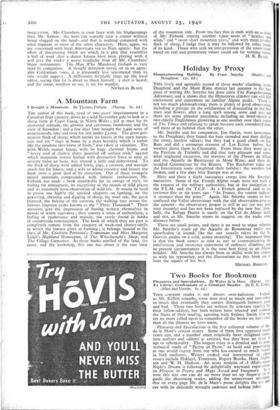Holiday by Proxy
Mountaineering Holiday. By Frank Smythe. (Hodder and Stoughton. I 2S. 6d.)
THIS lively and agreeable record of three weeks' climbing in the Dauphine and the Mont Blanc district last summer is the best piece of writing Mr. Smythe has done since The Kangchenjunga Adventure, and it shows that the Himalayan climber can still find excitement and enjoyment on familiar Alpine peaks. There is not too much philosophising; there is plenty of good observation, including a passage on the exhilaration of descending to the first trees and flowers after a long spell among snow and ice; and there are some pleasant anecdotes; including an hotel-sketch of two elderly Englishmen glowering at one another over their copies of The Times and refusing to speak because each considered him- self more of an habitué than the other.
Mr. Smythe and his companion, Jim Gavin, were newcomers to the Dauphine; they found the huts crowded and they disliked the stony, treeless valleys; but they had a good climb on Les Bans and did a strenuous traverse of Les Ecrins before bad weather drove them to Chamonix. From there they went up to the Pavilion de Trelatete and did that very pleasant and some- what neglected excursion, the traverse of the Domes de Miage and the Aiguille de Bionnassay to Mont Blanc, and then de- scended Courmayeur by the Brenva. The Rochefort ridge and the Innominata route completed their holiday: the weather had broken, and a few days later Europe was at war.
Here and there a slight inaccuracy creeps into Mr Smythe's narratives. Some of the French Alpine roads were not built at the request of the military authorities, but at the instigation of the P.L.M. and the T.C.F. As a French general said to the reviewer five or six years ago : " In France, the tourist industry is stronger than the army." Again, Mr. Smythe seems to have confused the Vallot observatory with the old observation-post on the summit : the observatory proper is still in use (or was until very recently) and has not been replaced by the new hut. Simi- larly, the Refuge Durier is surely on the Col de Miage itself, and not, as Mr. Smythe seems to suggest, on the rocks some distance below.
These are small points, and there is no need to argue whether Mr. Smythe's route up the Aiguille de Bionnassay really was unorthodox (it sounds like the one usually taken by the St. Gervais guides on a cold, sunny morning). The important thMg is that the book comes as near as any to communicating the exhilaration and strenuous enjoyment of ordinary climbing, and in present circumstances it is the next best thing to an Alpine holiday. Mr. Smythe has always been as skilful with his camera as with his typewriter, and the illustrations to this book are at least the equals of his best.
MICHAEL ROBERTS.






























 Previous page
Previous page